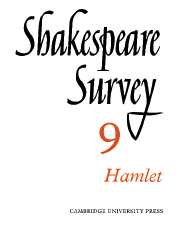Book contents
- Frontmatter
- Studies in Hamlet, 1901–1955
- English Hamlets of the Twentieth Century
- The Date of Hamlet
- Hamlet and the Court of Elsinore
- Hamlet’s ‘Sullied’ or ‘Solid’ Flesh: A Bibliographical Case–History
- Hamlet at the Globe
- Hamlet Costumes from Garrick to Gielgud
- Hamlet at the Comédie Française: 1769–1896
- The New Way with Shakespeare’s Texts: An Introduction for Lay Readers. III. In Sight of Shakespeare’s Manuscripts
- Shakespeare in the Bibliotheca Bodmeriana
- An Unpublished Contemporary Setting of a Shakespeare Song
- Garrick’s Stratford Jubilee: Reactions in France and Germany
- Shakespeare and Bohemia
- International Notes
- Shakespeare Productions in the United Kingdom: 1954
- The Tragic Curve: A Review of two Productions of Macbeth
- The Year's Contributions to Shakespearian Study 1 Critical Studies
- 2 Shakespeare’s Life, Times and Stage
- 3 Textual Studies
- Book Received
- Index
- Plate Section
Shakespeare and Bohemia
Published online by Cambridge University Press: 28 March 2007
- Frontmatter
- Studies in Hamlet, 1901–1955
- English Hamlets of the Twentieth Century
- The Date of Hamlet
- Hamlet and the Court of Elsinore
- Hamlet’s ‘Sullied’ or ‘Solid’ Flesh: A Bibliographical Case–History
- Hamlet at the Globe
- Hamlet Costumes from Garrick to Gielgud
- Hamlet at the Comédie Française: 1769–1896
- The New Way with Shakespeare’s Texts: An Introduction for Lay Readers. III. In Sight of Shakespeare’s Manuscripts
- Shakespeare in the Bibliotheca Bodmeriana
- An Unpublished Contemporary Setting of a Shakespeare Song
- Garrick’s Stratford Jubilee: Reactions in France and Germany
- Shakespeare and Bohemia
- International Notes
- Shakespeare Productions in the United Kingdom: 1954
- The Tragic Curve: A Review of two Productions of Macbeth
- The Year's Contributions to Shakespearian Study 1 Critical Studies
- 2 Shakespeare’s Life, Times and Stage
- 3 Textual Studies
- Book Received
- Index
- Plate Section
Summary
An enduring link between Shakespeare’s work and “fair Bohemia” has been forged by the poet himself. His fanciful geography has for ever endeared him to the land-locked Bohemians, and The Winter’s Tale has frequently been produced with elaborate splendour and appropriate local colour in Prague. In the magnificent tercentenary pageant of 1864, unique in the annals of the continental stage, it was sweet Perdita, symbolizing the long-lost and newly recovered arts of Bohemia, who played the most prominent part among the two hundred and thirty Shakespearian characters represented.
First Translation
In tracing the successive stages of the cult of Shakespeare in Bohemia and of the invigorating impact of his genius on the revival of the Czech national spirit one has to bear in mind the complexities of the historical background. The collapse of Bohemian independence after 1620 left the German and Catholic minorities in possession of the country. As a result of a system of calculated oppression the Czech language, banished from polite use, gradually declined to the level of a peasant patois. With the upper classes exiled or alienated and the political centre shifted to Vienna, the social and intellectual life of the Bohemian cities was exposed to intense Germanization. By 1781, however, the year of the edicts guaranteeing partial religious toleration and emancipation of the enslaved peasantry, the long night was ending—and it is noteworthy that in the following year the first crude Czech paraphrases of Macbeth and The Merchant of Venice were printed in a provincial town of South Bohemia in the form of popular chapbooks.
- Type
- Chapter
- Information
- Shakespeare Survey , pp. 101 - 110Publisher: Cambridge University PressPrint publication year: 1956
- 1
- Cited by

